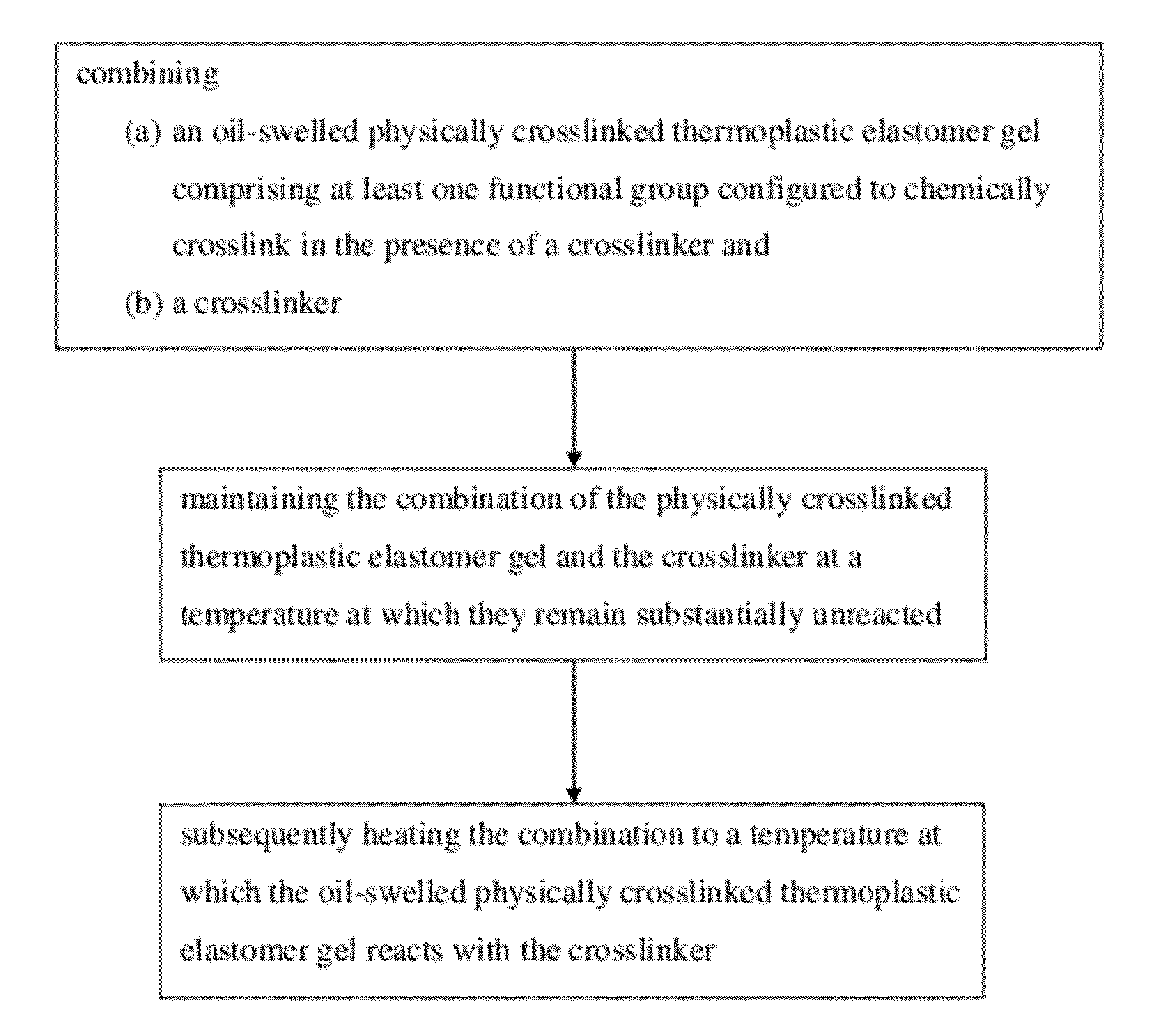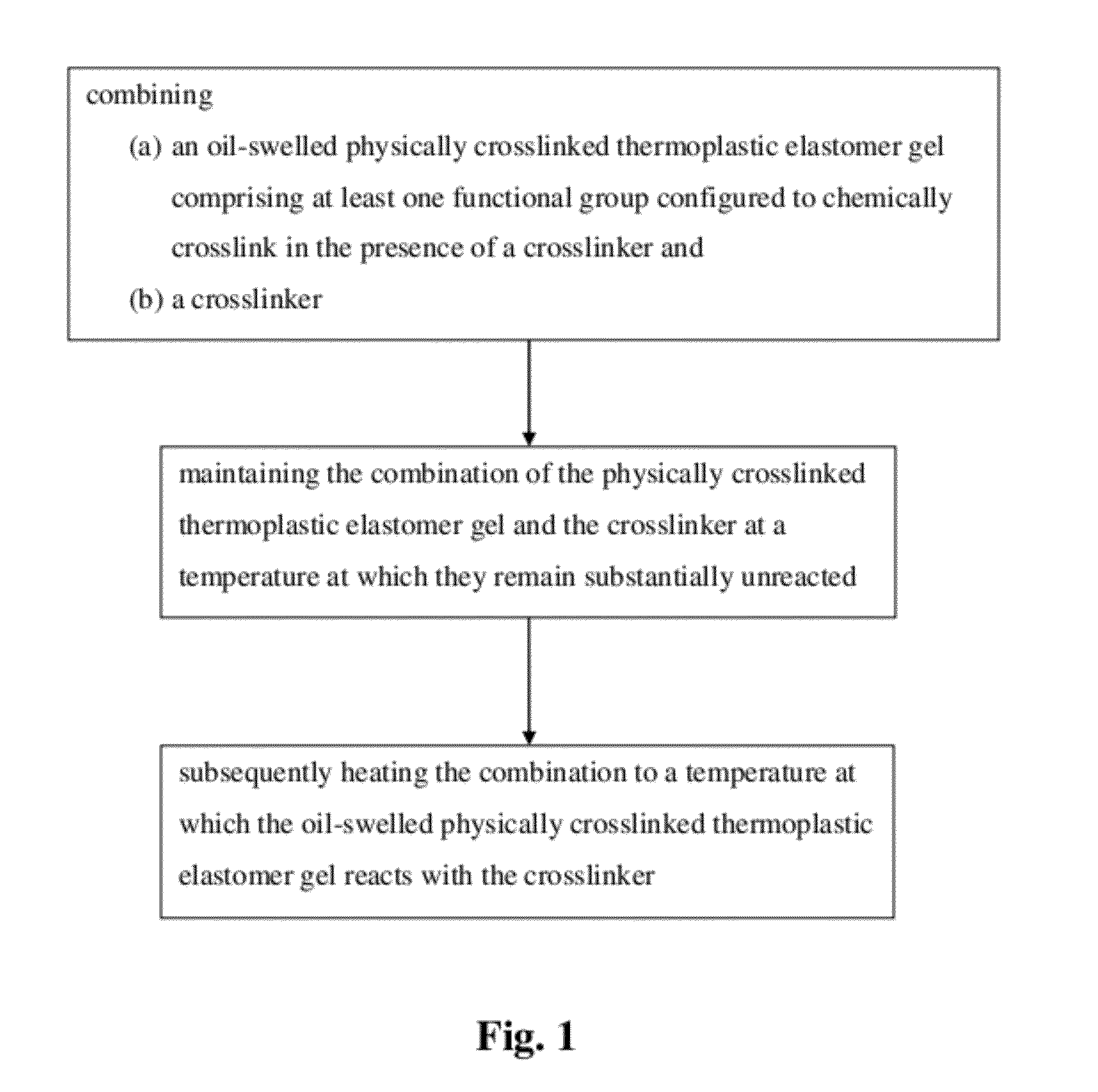Methods of Processing High Service Temperature Hydrocarbon Gels
a hydrocarbon gel and high service temperature technology, applied in the field of polymer gels, can solve the problems of poor sealing properties of gels, increasing the environmental environment of high temperature environments, and increasing performance requirements of sealants, and achieves the effect of improving the sealing
- Summary
- Abstract
- Description
- Claims
- Application Information
AI Technical Summary
Benefits of technology
Problems solved by technology
Method used
Image
Examples
example 1
[0058]The system of FIG. 2 can be used to make a thermoset object with an oil-swelled theromoplastic gel and a crosslinker. A room temperature slurry of the softener oil, block copolymers, stabilizers, and flame retardant additives is created using a Henschel mixer. The cold slurry is then poured into a drum. The drum is sent to a specific location where it is dispensed. A drum unloader with a room temperature platen is used to dispense the slurry. The slurry then flows through a hot static mixer. In this configuration, the hot static mixer simultaneously heats the gel and mixes the composition comprising the gel and crosslinker fully. The mixed, hot molten gel is then inserted into an injection molder to mold parts.
example 2
[0059]The following flame retardant gel, in which the percentages are given as weight percent of the total gel composition, can be processed according to the described methods.
Weight %KRATON MD6684 CS2KRATON G17015Stabilizer Composition1DURASYN 14852Flame Retardant Mixture40
[0060]A flame retardant gel was prepared as follows. A flame retardant mixture was made of ammonium polyphosphate, FR CROS C60 from Budenheim, (Zaragoza, Spain), melamine (Sigma-Aldrich) and pentaerythritol (CHARMOR PM40 Perstorp) in a 3:1:1 ratio. A stabilizer composition was made of IRGANOX 1076 (Ciba), IRGANOX B225 (Ciba), TINUVIN 327 (Ciba), METASOL TK-100 (Lanxess) in a 1:1:1:0.12 ratio. The resulting gel had about a 20 g hardness measured using a texture analyzer. The resulting gel is also thermomechanically stable at high service temperatures (approximately 120° C.). Flame-retardancy was measured using the Underwriters Laboratory standard UL 94. The resulting gel was found to be highly flame retardant (V-0...
example 3
[0061]The following flame retardant gel, in which the percentages are given as weight percent of the total gel composition, can be processed according to the described methods.
Weight %KRATON MD6684 CS3KRATON G17012Stabilizer Composition0.78HYDROBRITE 380 PO44.22Flame Retardant Mixture50
[0062]The stabilizer composition was made of IRGANOX 1076 (Ciba), IRGANOX B225 (Ciba), TINUVIN 327 (Ciba), METASOL TK-100 (Lanxess) in a 1:1:1:0.12 ratio. The resulting gel was found to be highly flame retardant (V-0 on the UL-94 vertical burn test).
PUM
| Property | Measurement | Unit |
|---|---|---|
| temperature | aaaaa | aaaaa |
| temperatures | aaaaa | aaaaa |
| temperature | aaaaa | aaaaa |
Abstract
Description
Claims
Application Information
 Login to View More
Login to View More - R&D
- Intellectual Property
- Life Sciences
- Materials
- Tech Scout
- Unparalleled Data Quality
- Higher Quality Content
- 60% Fewer Hallucinations
Browse by: Latest US Patents, China's latest patents, Technical Efficacy Thesaurus, Application Domain, Technology Topic, Popular Technical Reports.
© 2025 PatSnap. All rights reserved.Legal|Privacy policy|Modern Slavery Act Transparency Statement|Sitemap|About US| Contact US: help@patsnap.com



